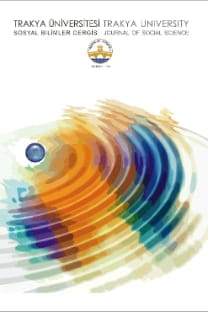HAVAALANI GÜVENLİK SÜREÇLERİNDEKİ PROBLEMLER VE HAVAALANI KULLANICILARI: HAVAALANI GÜVENLIK GÖREVLİSİ PERSPEKTİFİNDEN TÜRKİYE’DEKİ ÜÇ HAVAALANINDA BIR ARAŞTIRMA
Çalışmanın amacı güvenlik görevlilerine sıkıntı verdiği düşünülen havaalanı kullanıcısı profile ile güvenlik prosedürlerinin belirlenmesi ve bu doğrultuda gerek insan kaynakları yönetimi gibi yönetsel süreçlere gerekse güvenlik prosedürlerinin geliştirilmesine katkı sağlanmasıdır. Bu amaçla yapılan araştırmada anket formu kullanılmıştır. Anket İstanbul Atatürk Havalimanı, Ankara Esenboğa Havalimanı ve İstanbul Sabiha Gökçen Havalimanı olmak üzere, üç havaalanın iç ve dış hatlar terminali kontrol noktasında görev yapmakta olan özel güvenlik görevlisine uygulanmıştır. Elde edilen verilere frekans analizi uygulanarak betimlenmiştir. Yolcu profiline yönelik yapılan analiz sonucunda her üç havaalanında da terminal personelinin süreçlerde büyük oranda sıkıntı yarattığı belirlenmiştir. Bunun yanı sıra yabancı yolculara oranla T.C. uyruklu ve tek başına seyahat eden yolculara oranla aileleri ile seyahat eden yolcuların güvenlik süreçlerinde daha fazla sıkıntıya neden olduğu her üç havaalanı verilerinde de saptanmıştır. En fazla sıkıntı yaşanmasına neden olan güvenlik sürecine yönelik bulguda ise havayolu ile taşınması yasaklı maddelerin tespiti, ayakkabı çıkarma uygulaması ve kapı detektöründen tekrar geçilmesi ilk üç sırada yer almıştır.
Anahtar Kelimeler:
Havayolu taşımacılığı, Havaalanı, Havaalanı güvenlik süreçleri, Yolcu profili, Güvenlik görevlisi
IRPORT SECURITY PROCESS PROBLEMS AND AIRPORT USERS: A SURVEY FROM THE PERSPECTIVE OF AIRPORT SECURITY PERSONNEL AT THREE AIRPORTS IN TURKEY
The aim of this study is to contribute both to administrative processes, such as human resources management, and to the improvement of security procedures by identifying an airport user profile that is perceived as causing difficulties and security procedures that create problems for security staff. For this purpose, a questionnaire form is used in the study. The questionnaire was administered to private security personnel working at the check points of three domestic and international airport terminals; namely, Istanbul Atatürk Airport, Ankara Esenboğa Airport and Istanbul Sabiha Gökçen Airport. The obtained data is described by applying frequency analysis. As a result of the analysis conducted on passenger profiles, the terminal personnel at all three airports were determined to have been caused great difficulties. It has also been revealed that, compared to foreign nationals, Turkish nationals created more difficulties and that, in addition, compared to lone travelers those traveling with their families created more problems at the security procedures at all three airports. The security process was identified as causing the greatest trouble, with the detection of prohibited items, the process of shoe removal and requests for re-entry through walk-through metal detectors found to be the three items cited with the highest frequency.
Keywords:
Air transport, airport, airport security processes, passenger profile, security personnel,
___
- “Civil Aviation Security Training and Certification Instructions” (SHT 17-2) http://web.shgm.gov.tr/documents/sivilhavacilik/files/mevzuat/sektorel/talimatlar/SHT-17.2.pdf (accessed March 2017).
- Eldar, Z. (October-December 2010), “The Human Factor in Aviation Security”, Journal of Airport Management, Vol.5, Iss.1, pp..34-39. http://www.dhmi.gov.tr/istatistik.aspx (accessed March 2017).
- Elias, B. (2012). “Airport Body Scanners: The Role of Advanced Imaging Technology in Airline Passenger Screening”. Congressional Research Service.
- Haas, E. P. (2004). “Back To The Future? The Use Of Biometrics, Its Impact On Aırport Securıty, And How Thıs Technology Should Be Governed”. Journal Of Air Law And Commerce, 69, 459-489.
- ICAO Annex 17 “Security” (March 2011). Ninth Edition.
- Kirschenbaum, Alan (Avi) (2013), “The cost of airport security: The passenger dilemma” Journal of Air Transport Management, Vo.30, pp.39-45.
- Kirschenbaum, Alan (Avi); Michele Mariani, Coen Van Gulijk, Sharon Lubasz, Carmit Rapaport, Hinke Andriessen (2012), “Airport security: An ethnographic study” Journal of Air Transport Management, Vol.18, pp.68-73.
- Gkritza, Konstantina, Debbie Niemeier; Fred Mannering (2006), “Airport security screening and changing passenger satisfaction: An exploratory assessment” Journal of Air Transport Management, Vol.12, Iss. 5, pp.213–219.
- Lange, Robert, Ilya Samoilovich, Bo van der Rhee (2013), “Virtual Queuing at Airport Security Lanes” European Journal of Operational Research, Vol. 225, Iss.1, pp. 153–165.
- Mclay A. Laura, Sheldon, H. Jacobson and John E. Kobza (2007), “Integer programming models and analysis for a multilevel passenger screening problem” IIE Transactions, Vol.39, Iss.1, pp.73–81.
- Directorate General of Civil Aviation (2016), National Civil Aviation Security Program.
- Rossiter, Adriana, Martin Dresner (2004), “The impact of the September 11th security fee and passenger wait time on traffic diversion and highway fatalities” Journal of Air Transport Management, Vol.10, Iss.4, pp. 225–230.
- Salter B. Mark (2007), “SeMS and sensibility: Security management systems and the management of risk in the Canadian Air Transport Security Authority”, Journal of Air Transport Management, Vol. 13, Iss.6, pp.389–398.
- Schwaninger, Adrian, Diana Hardmeier, Judith Reigeling, Mike Martin (2010), “Use It and Still Lose It? The Influence of Age and Job Experience on Detection Performance in X-Ray Screenin”, GeroPsych Vol.23, Iss.3, pp. 169-175.
- Shanks N.E.L., A.L.W. Bradley (2004) Handbook of Checked Baggage Screening Professional Engineering Publishing Limited, Wiltshire UK.
- Sindhav, Birud, Jonna Holland, Amy Risch Rodie, Phani Tej Adidam, Lousi G. Pol (2006), “The Impact of Perceived Fairness on Satisfaction: Are Airport Security Measures Fair? Does It Matter?” Journal of Marketing Theory and Practice, Vol.14, No.4, pp. 323-335.
- Star, G. (2002). “Airport Securıty Technology: Is The Use Of Biometric Identıfıcatıon Technology Valıd Under The Fourth Amendment?”. Temple Environmental Law & Technology Journal, 20 (2), 251-265.
- Stewart, Mark G., Mueller John (2014), “Cost-benefit analysis of airport security: Are airports too safe?” Journal of Air Transport Management, Vol.35, pp. 19-28.
- Yoo, Kwang Eui, Youn Chul Choi (2006), “Analytic hierarchy process approach for identifying relative importance of factors to improve passenger security checks at airports”, Journal of Air Transport Management, Vol.12, Iss.3, pp.135–142.
- ISSN: 1305-7766
- Yayın Aralığı: Yılda 2 Sayı
- Başlangıç: 2000
- Yayıncı: Trakya Üniversitesi Sosyal Bilimler Enstitüsü
Sayıdaki Diğer Makaleler
İMALAT İŞLETMELERİNDE YENİ ÜRÜN GELİŞTİRME KRİTERLERİ: KARADENİZ BÖLGESİ ÖRNEĞİ
ARKEOLOJİK ÇAĞLARDA ANADOLU'DA MÜZİK
KIRSAL TURİZMDE İŞLETMELERİN ROLÜ: CUMALIKIZLIK ÖRNEĞİ
Reyhan ARSLAN AYAZLAR, Miray KILIÇALP
ARİF’İN NÜSHA-İ ÂLEM MESNEVİSİNDE ÂLEM-İNSAN İLİŞKİSİ
BİTLİS'TE GELENEKSEL AYAKKABICILIK: “HARİK” ve SON USTA HAYDAR YILMAZ
Sultan SÖKMEN, Zeynep BALKANAL
MARX’TA İDEOLOJİ ELEŞTİRİSİ VE KAVRAMIN FARKLILAŞAN GÖRÜNÜMLERİ
